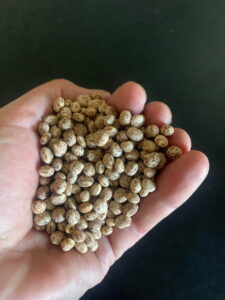The little known lupin is likely the most powerful superfood you’ve never heard of. While lupins have been used as a food for as much as 6000 years in the Andean highlands and over 3000 years around the Mediterranean, they are slowly making their way onto supermarket shelves in Australia and around the globe. Meanwhile, farmers are recognising their multiple advantages in both sustainable cropping systems and as a high-protein addition to animal feed.
With over 200 species, lupins are grown in a wide array of regions across the globe, ranging from the Mediterranean to the southwestern United States, northern Mexico to both eastern and western parts of Australia. Two varieties of lupin are most commonly grown in Australia, with the majority of lupin production occurring in the winter/spring rain-fed parts of southwestern Western Australia. Australia produces about 730,000 metric tonnes of lupins per year, the equivalent of approximately 80–85% of the world’s lupin production. About 30% are used domestically within Australia, while approximately 70% are exported to Asia, North Africa and the Middle East for animal feed. As a high-protein grain, lupins are most commonly grown and harvested for human and animal consumption, yet they also hold many advantages in both cropping and mixed cropping–livestock farming systems.
Farmers can enrich their soil naturally by planting an annual that produces a kaleidoscope of pea-like flowers with bold spikes of vibrant purples, pinks and blues, rich reds and yellows, or crisp, clean whites, attracting a range of pollinators including bees and butterflies. In regenerative cropping systems, lupins produce a significant nitrogen contribution for subsequent crops in soils. They provide a disease break for cereal crops and can help control grass weeds within well planned cropping sequences. With taproots that stretch deep into the earth, lupins are drought-tolerant and also help break up compacted soil. When lupin plants die back, the taproots slowly break down, increasing the organic content in the soil, helping the soil retain water. These combined benefits can increase the yields of cereals following lupin crop rotation, particularly when grown in sandy soils.
 The nutrient content of lupin grain, in protein, amino acid, energy and mineral levels makes it both a nutritional and economical addition to stock feed formulations. Among the various grain legumes used in stock feed, lupins can be used as an alternative to soybeans and are highly regarded as feed for poultry, pigs, ruminants, and fish. Research has shown that replacing soybean meal with lupin meal as an alternative poultry protein feed source reduces cost of production and improves poultry egg productivity. In other studies, using lupin grain in feed rations has been shown to increase the milk production of beef and dairy cattle. It can be more valuable to include in the diet than cereal grain because it tends to not lower the fat content of milk (as high levels of cereal grains may do). Researchers have also investigated the potential for lupin grain to be used as a plant based feed source in aquaculture operations and found that lupin was particularly useful for fish diets because of the highly digestible level of protein, good levels of digestible energy and highly digestible phosphorus.
The nutrient content of lupin grain, in protein, amino acid, energy and mineral levels makes it both a nutritional and economical addition to stock feed formulations. Among the various grain legumes used in stock feed, lupins can be used as an alternative to soybeans and are highly regarded as feed for poultry, pigs, ruminants, and fish. Research has shown that replacing soybean meal with lupin meal as an alternative poultry protein feed source reduces cost of production and improves poultry egg productivity. In other studies, using lupin grain in feed rations has been shown to increase the milk production of beef and dairy cattle. It can be more valuable to include in the diet than cereal grain because it tends to not lower the fat content of milk (as high levels of cereal grains may do). Researchers have also investigated the potential for lupin grain to be used as a plant based feed source in aquaculture operations and found that lupin was particularly useful for fish diets because of the highly digestible level of protein, good levels of digestible energy and highly digestible phosphorus.
While the crop is grown mostly to produce stock feed, there is a small, but growing market for lupin grain for human consumption. Lupins are slowly growing in popularity among consumers due to their many health benefits: protein-rich, highly nutritious, sustainable, and versatile, lupins are a powerhouse of goodness. They are one of the richest sources of plant protein and fibre (at least twice as much as other legumes) and packed full of nutrients and antioxidants including thiamine, riboflavin, vitamin C, calcium, potassium, phosphorus, magnesium, iron and zinc. Eating lupin beans has been linked to lowering blood pressure, improving blood lipids and insulin sensitivity and favourably altering the gut microbiome in studies. The Australian food industry is beginning to recognise the value of lupin and a range of lupin products are now available, including whole lupin flakes, flour, crumb, semolina, or enriched food products such as pasta, cereal and cookie mix.
ORICoop has been working with key organic growers in Western Australia and the Riverina – to expand and diversify their crop selections to include lupins. This provides producers a unique and valuable intercrop option – and enables a strong cash crop for organic dairy and poultry producers. ‘There is a strong appetite for lupins as a livestock feed, and with our Farmers Own ‘ORCA’ Brand we are pushing through the barriers to get bulk lupins from growers to end users in Victoria, Southern Australia and Queensland. Our next ambition is to tap into strategic export markets. This legume has a well deserved place of prominence in the organic and regenerative cropping market – and we are looking forward to it’s initiation across the Australian organic sector’ says Carolyn, ORICoop Executive Director
Ian and Jodi are well experienced with growing lupins in Western Australia. And are thriving in growing them under an organic system. ‘Lupin crops play a pivotal role in the viability of organic and regenerative farming systems in Western Australia. They present to the farmer a range of critical advantages over other crop rotation options available such as suitability in deep acid sandy soils, excellent nitrogen fixation capability, disease resistance and disease break for other crops, impressive stockfeed quality and volume of post harvest residues and competitive demand and value of lupin seeds.
 Nitrogen is typically applied to a crop in the form of urea, and although urea application can result in vigorous crop growth it has a hidden destructive action on soil health and long term fertility that requires additional fertilisation to overcome. Organic and regenerative farming systems limit or prohibit the use of urea for this reason. Lupins can fix similar levels of nitrogen from the atmosphere directly into the soil naturally and even increase soil health making them the goto natural fertiliser for the environmentally conscious consumer and farmer. The lupin seed and after harvest crop residues provide an additional benefit of an outstanding high value stockfeed source for grazing ewes and lambs. Ewes and lambs grazing or being fed lupins outperform those running on grass crop feeds and harvest residues providing substantially more lambs and reach market weight far quicker than those running on grass crop grains and residues.
Nitrogen is typically applied to a crop in the form of urea, and although urea application can result in vigorous crop growth it has a hidden destructive action on soil health and long term fertility that requires additional fertilisation to overcome. Organic and regenerative farming systems limit or prohibit the use of urea for this reason. Lupins can fix similar levels of nitrogen from the atmosphere directly into the soil naturally and even increase soil health making them the goto natural fertiliser for the environmentally conscious consumer and farmer. The lupin seed and after harvest crop residues provide an additional benefit of an outstanding high value stockfeed source for grazing ewes and lambs. Ewes and lambs grazing or being fed lupins outperform those running on grass crop feeds and harvest residues providing substantially more lambs and reach market weight far quicker than those running on grass crop grains and residues.
With its unique macro and micro nutrient composition, there is growing evidence that incorporating lupin ingredients into animal and human diets can have direct health benefits. On farms, the benefits range from improved soil structure and water efficiency to increased yields and profitability. With its wealth of advantages, lupins are fast becoming a key ingredient in sustainable agriculture and sustainable diets.
To enquire about bulk lupins you can contact ORICoop HERE
Story written by Eva Perroni
References
- Australian Export Grains Innovation Centre (2021) Australian lupins for dairy cattle. Australian Export Grains Innovation Centre, Perth, Australia.
- Beyene, G., Ameha N., Urge M., Estifanos A. (2014) Replacing soybean meal with processed Lupin (Lupinus Albus) meal as poultry layers feed. Livestock Research for Rural Development 26(11).
- Encyclopedia of Food Grains (Second Edition), (2016) Lupine: An Overview. VOLUME 1, Pages 280-286.
- Grains Research and Development Corporation (2018) Lupin as a feed source. Grains Research and Development Corporation, Canberra Australia.
- Kouris-Blazos & Belski. (2016) Health benefits of legumes and pulses with a focus on Australian sweet lupins. Asia Pac J Clin Nutr. 25(1): 1-17. https://pubmed.ncbi.nlm.nih.gov/26965756/

